Luseogliflozin, a SGLT2 Inhibitor, Does Not Affect Glucose Uptake Kinetics in Renal Proximal Tubules of Live Mice
Abstract
1. Introduction
2. Results
2.1. In Vivo Analysis of Glucose Dynamics in Skeletal Muscle Using Multiphoton Imaging
2.2. Analysis of Glucose Dynamics in Proximal Tubules of Live Animals
2.3. Effect of Luseogliflozin on Glucose Dynamics in Proximal Tubules
2.4. Effects of Blood Glucose Level on Glucose Dynamics in Proximal Tubules
2.5. Effect of Blood Glucose Level on Basolateral Glucose Transport in Proximal Tubules
2.6. Effects of Luseogliflozin on Glucose Uptake in Cultured Proximal Tubule Cells
3. Discussion
4. Materials and Methods
4.1. Materials
4.2. In Vivo Imaging
4.3. Western Blot
4.4. Cell Culture
4.5. Statistical Analysis
Supplementary Materials
Author Contributions
Funding
Institutional Review Board Statement
Informed Consent Statement
Data Availability Statement
Acknowledgments
Conflicts of Interest
References
- Zinman, B.; Wanner, C.; Lachin, J.; Fitchett, D.H.; Bluhmki, E.; Hantel, S.; Mattheus, M.; Devins, T.; Johansen, O.E.; Woerle, H.J.; et al. Empagliflozin, Cardiovascular Outcomes, and Mortality in Type 2 Diabetes. N. Engl. J. Med. 2015, 373, 2117–2128. [Google Scholar] [CrossRef] [PubMed]
- Heerspink, H.J.; Stefánsson, B.V.; Correa-Rotter, R.; Chertow, G.M.; Greene, T.; Hou, F.-F.; Mann, J.F.; McMurray, J.J.; Lindberg, M.; Rossing, P.; et al. Dapagliflozin in Patients with Chronic Kidney Disease. N. Engl. J. Med. 2020, 383, 1436–1446. [Google Scholar] [CrossRef] [PubMed]
- Thorens, B. GLUT2, glucose sensing and glucose homeostasis. Diabetologia 2014, 58, 221–232. [Google Scholar] [CrossRef] [PubMed]
- Fehr, M.; Takanaga, H.; Ehrhardt, D.W.; Frommer, W.B. Evidence for High-Capacity Bidirectional Glucose Transport across the Endoplasmic Reticulum Membrane by Genetically Encoded Fluorescence Resonance Energy Transfer Nanosensors. Mol. Cell. Biol. 2005, 25, 11102–11112. [Google Scholar] [CrossRef] [PubMed]
- Eisenberg, M.; Maker, A.V.; Slezak, L.A.; Nathan, J.D.; Sritharan, K.C.; Jena, B.P.; Geibel, J.P.; Andersen, D.K. Insulin Receptor (IR) and Glucose Transporter 2 (GLUT2) Proteins Form a Complex on the Rat Hepatocyte Membrane. Cell. Physiol. Biochem. 2005, 15, 051–058. [Google Scholar] [CrossRef] [PubMed]
- Kanai, Y.; Lee, W.S.; You, G.; Brown, D.; Hediger, M. The human kidney low affinity Na+/glucose cotransporter SGLT Delineation of the major renal reabsorptive mechanism for D-glucose. J. Clin. Investig. 1994, 93, 397–404. [Google Scholar] [CrossRef]
- Zhang, Y.; Nakano, D.; Guan, Y.; Hitomi, H.; Uemura, A.; Masaki, T.; Kobara, H.; Sugaya, T.; Nishiyama, A. A sodium-glucose cotransporter 2 inhibitor attenuates renal capillary injury and fibrosis by a vascular endothelial growth factor–dependent pathway after renal injury in mice. Kidney Int. 2018, 94, 524–535. [Google Scholar] [CrossRef]
- Ansary, T.M.; Fujisawa, Y.; Rahman, A.; Nakano, D.; Hitomi, H.; Kobara, H.; Masaki, T.; Titze, J.M.; Kitada, K.; Nishiyama, A. Responses of renal hemodynamics and tubular functions to acute sodium–glucose cotransporter 2 inhibitor administration in non-diabetic anesthetized rats. Sci. Rep. 2017, 7, 1–9. [Google Scholar] [CrossRef]
- Kojima, N.; Williams, J.M.; Takahashi, T.; Miyata, N.; Roman, R.J. Effects of a New SGLT2 Inhibitor, Luseogliflozin, on Diabetic Nephropathy in T2DN Rats. J. Pharmacol. Exp. Ther. 2013, 345, 464–472. [Google Scholar] [CrossRef]
- Smeets, B.; Boor, P.; Dijkman, H.; Sharma, S.V.; Jirak, P.; Mooren, F.; Berger, K.; Bornemann, J.; Gelman, I.H.; Floege, J.; et al. Proximal tubular cells contain a phenotypically distinct, scattered cell population involved in tubular regeneration. J. Pathol. 2012, 229, 645–659. [Google Scholar] [CrossRef]
- Hato, T.; Winfree, S.; Day, R.; Sandoval, R.M.; Molitoris, B.A.; Yoder, M.; Wiggins, R.; Zheng, Y.; Dunn, K.W.; Dagher, P.C. Two-Photon Intravital Fluorescence Lifetime Imaging of the Kidney Reveals Cell-Type Specific Metabolic Signatures. J. Am. Soc. Nephrol. 2017, 28, 2420–2430. [Google Scholar] [CrossRef]
- Schuh, C.D.; Polesel, M.; Platonova, E.; Haenni, D.; Gassama, A.; Tokonami, N.; Ghazi, S.; Bugarski, M.; Devuyst, O.; Ziegler, U.; et al. Combined Structural and Functional Imaging of the Kidney Reveals Major Axial Differences in Proximal Tubule Endocytosis. J. Am. Soc. Nephrol. 2018, 29, 2696–2712. [Google Scholar] [CrossRef] [PubMed]
- Uldry, M.; Ibberson, M.; Hosokawa, M.; Thorens, B. GLUT2 is a high affinity glucosamine transporter. FEBS Lett. 2002, 524, 199–203. [Google Scholar] [CrossRef]
- Kitada, K.; Nakano, D.; Ohsaki, H.; Hitomi, H.; Minamino, T.; Yatabe, J.; Felder, R.A.; Mori, H.; Masaki, T.; Kobori, H.; et al. Hyperglycemia causes cellular senescence via a SGLT2- and p21-dependent pathway in proximal tubules in the early stage of diabetic nephropathy. J. Diabetes Complicat. 2014, 28, 604–611. [Google Scholar] [CrossRef] [PubMed]
- Tanaka, S.; Sugiura, Y.; Saito, H.; Sugahara, M.; Higashijima, Y.; Yamaguchi, J.; Inagi, R.; Suematsu, M.; Nangaku, M.; Tanaka, T. Sodium–glucose cotransporter 2 inhibition normalizes glucose metabolism and suppresses oxidative stress in the kidneys of diabetic mice. Kidney Int. 2018, 94, 912–925. [Google Scholar] [CrossRef]
- Onishi, A.; Fu, Y.; Patel, R.; Darshi, M.; Crespo-Masip, M.; Huang, W.; Song, P.; Freeman, B.; Kim, Y.C.; Soleimani, M.; et al. A role for tubular Na+/H+ exchanger NHE3 in the natriuretic effect of the SGLT2 inhibitor empagliflozin. Am. J. Physiol. Physiol. 2020, 319, F712–F728. [Google Scholar] [CrossRef]
- McClatchey, P.M.; Williams, I.M.; Xu, Z.; Mignemi, N.A.; Hughey, C.C.; McGuinness, O.P.; Beckman, J.A.; Wasserman, D.H. Perfusion controls muscle glucose uptake by altering the rate of glucose dispersion in vivo. Am. J. Physiol. Metab. 2019, 317, E1022–E1036. [Google Scholar] [CrossRef]
- Williams, I.M.; Valenzuela, F.A.; Kahl, S.D.; Ramkrishna, D.; Mezo, A.R.; Young, J.D.; Wells, K.S.; Wasserman, D.H. Insulin exits skeletal muscle capillaries by fluid-phase transport. J. Clin. Investig. 2018, 128, 699–714. [Google Scholar] [CrossRef]
- Lizunov, V.A.; Stenkula, K.; Lisinski, I.; Gavrilova, O.; Yver, D.R.; Chadt, A.; Al-Hasani, H.; Zimmerberg, J.; Cushman, S.W. Insulin stimulates fusion, but not tethering, of GLUT4 vesicles in skeletal muscle of HA-GLUT4-GFP transgenic mice. Am. J. Physiol. Metab. 2012, 302, E950–E960. [Google Scholar] [CrossRef]
- Patki, V.; Buxton, J.; Chawla, A.; Lifshitz, L.; Fogarty, K.; Carrington, W.; Tuft, R.; Corvera, S. Insulin Action on GLUT4 Traffic Visualized in Single 3T3-L1 Adipocytes by Using Ultra-fast Microscopy. Mol. Biol. Cell 2001, 12, 129–141. [Google Scholar] [CrossRef]
- Hayashi, T.; Wojtaszewski, J.; Goodyear, L.J. Exercise regulation of glucose transport in skeletal muscle. Am. J. Physiol. Metab. 1997, 273, E1039–E1051. [Google Scholar] [CrossRef] [PubMed]
- Honka, M.-J.; Latva-Rasku, A.; Bucci, M.; Virtanen, K.A.; Hannukainen, J.; Kalliokoski, K.; Nuutila, P. Insulin-stimulated glucose uptake in skeletal muscle, adipose tissue and liver: A positron emission tomography study. Eur. J. Endocrinol. 2018, 178, 523–531. [Google Scholar] [CrossRef] [PubMed]
- Wasserman, D.H.; Kang, L.; Ayala, J.E.; Fueger, P.T.; Lee, R. The physiological regulation of glucose flux into muscle in vivo. J. Exp. Biol. 2011, 214, 254–262. [Google Scholar] [CrossRef] [PubMed]
- Nakano, D.; Doi, K.; Kitamura, H.; Kuwabara, T.; Mori, K.; Mukoyama, M.; Nishiyama, A. Reduction of Tubular Flow Rate as a Mechanism of Oliguria in the Early Phase of Endotoxemia Revealed by Intravital Imaging. J. Am. Soc. Nephrol. 2015, 26, 3035–3044. [Google Scholar] [CrossRef] [PubMed]
- Nakano, D.; Kitada, K.; Wan, N.; Zhang, Y.; Wiig, H.; Wararat, K.; Yanagita, M.; Lee, S.; Jia, L.; Titze, J.M.; et al. Lipopolysaccharide induces filtrate leakage from renal tubular lumina into the interstitial space via a proximal tubular Toll-like receptor 4–dependent pathway and limits sensitivity to fluid therapy in mice. Kidney Int. 2020, 97, 904–912. [Google Scholar] [CrossRef] [PubMed]
- Uchida, S.; Mitani, A.; Gunji, E.; Takahashi, T.; Yamamoto, K. In vitro characterization of luseogliflozin, a potent and competitive sodium glucose co-transporter 2 inhibitor: Inhibition kinetics and binding studies. J. Pharmacol. Sci. 2015, 128, 54–57. [Google Scholar] [CrossRef] [PubMed][Green Version]
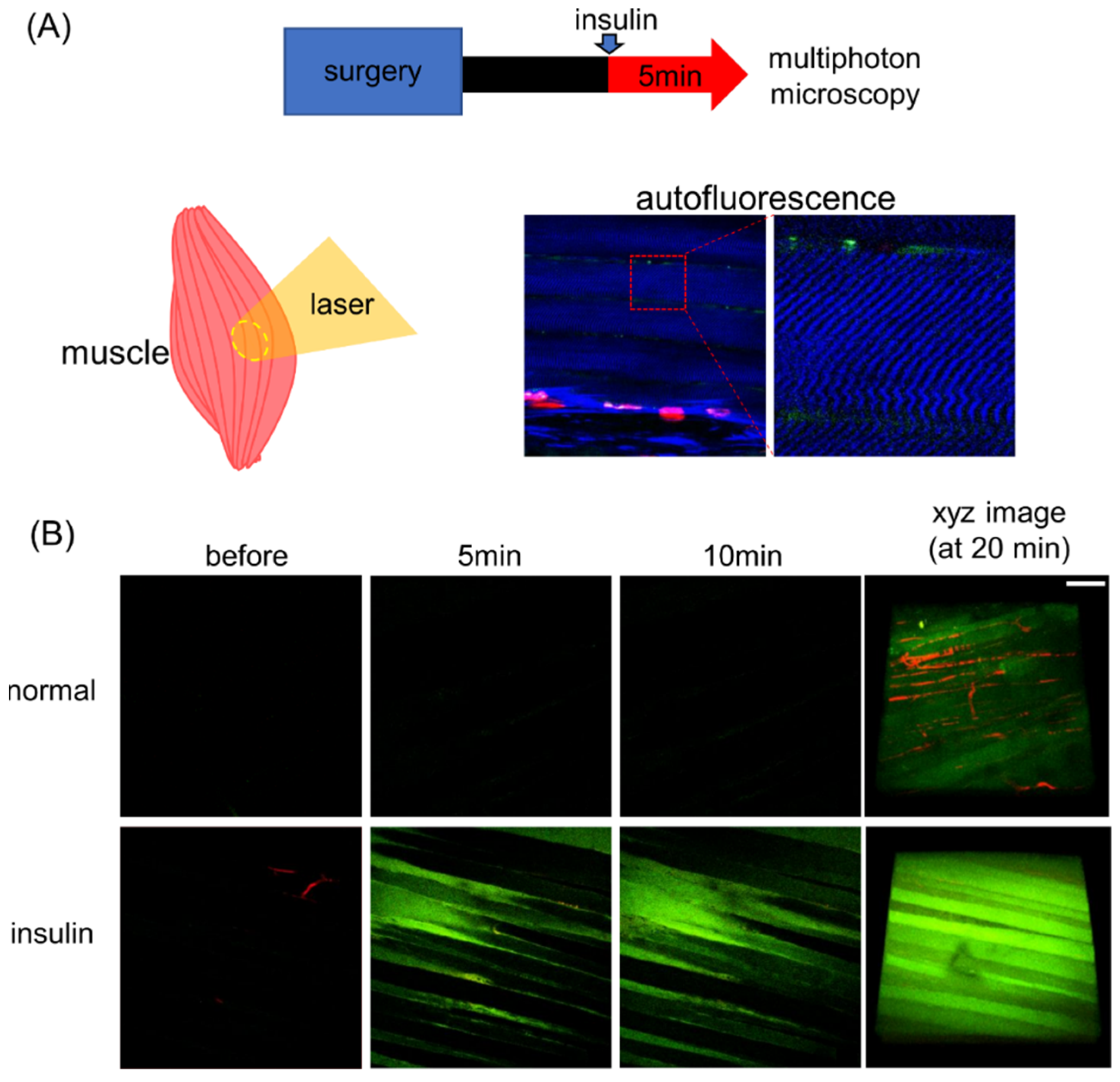
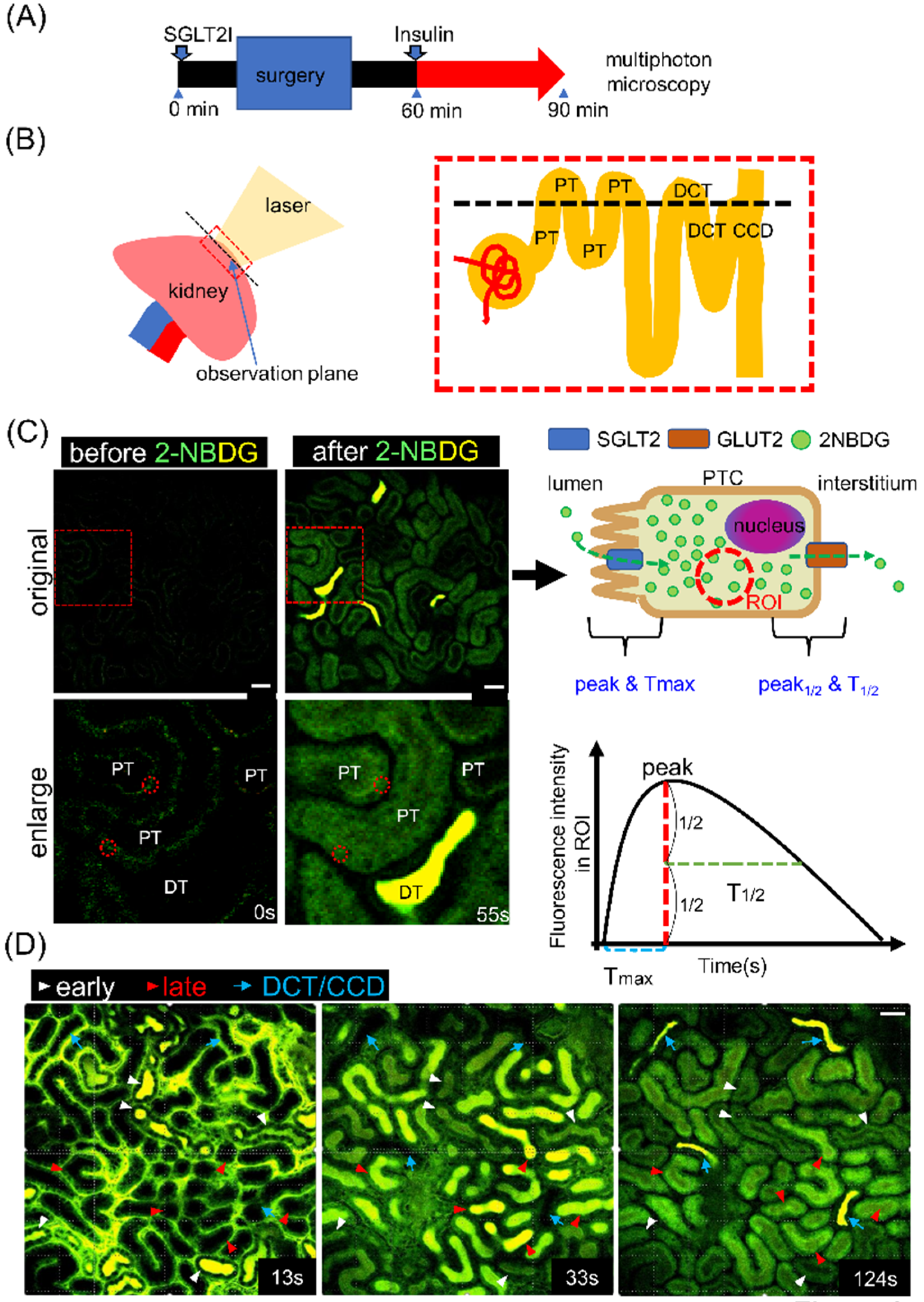
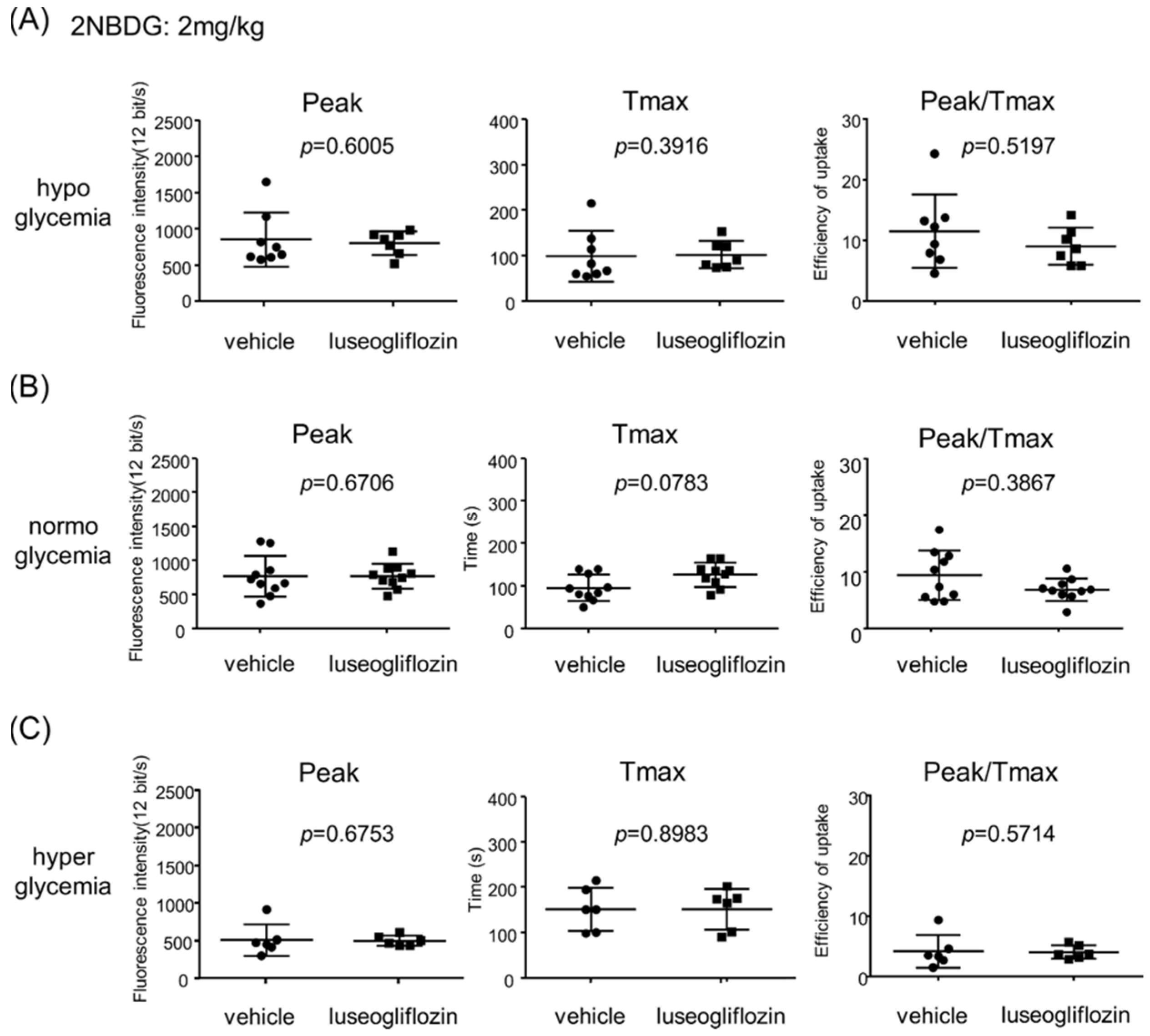
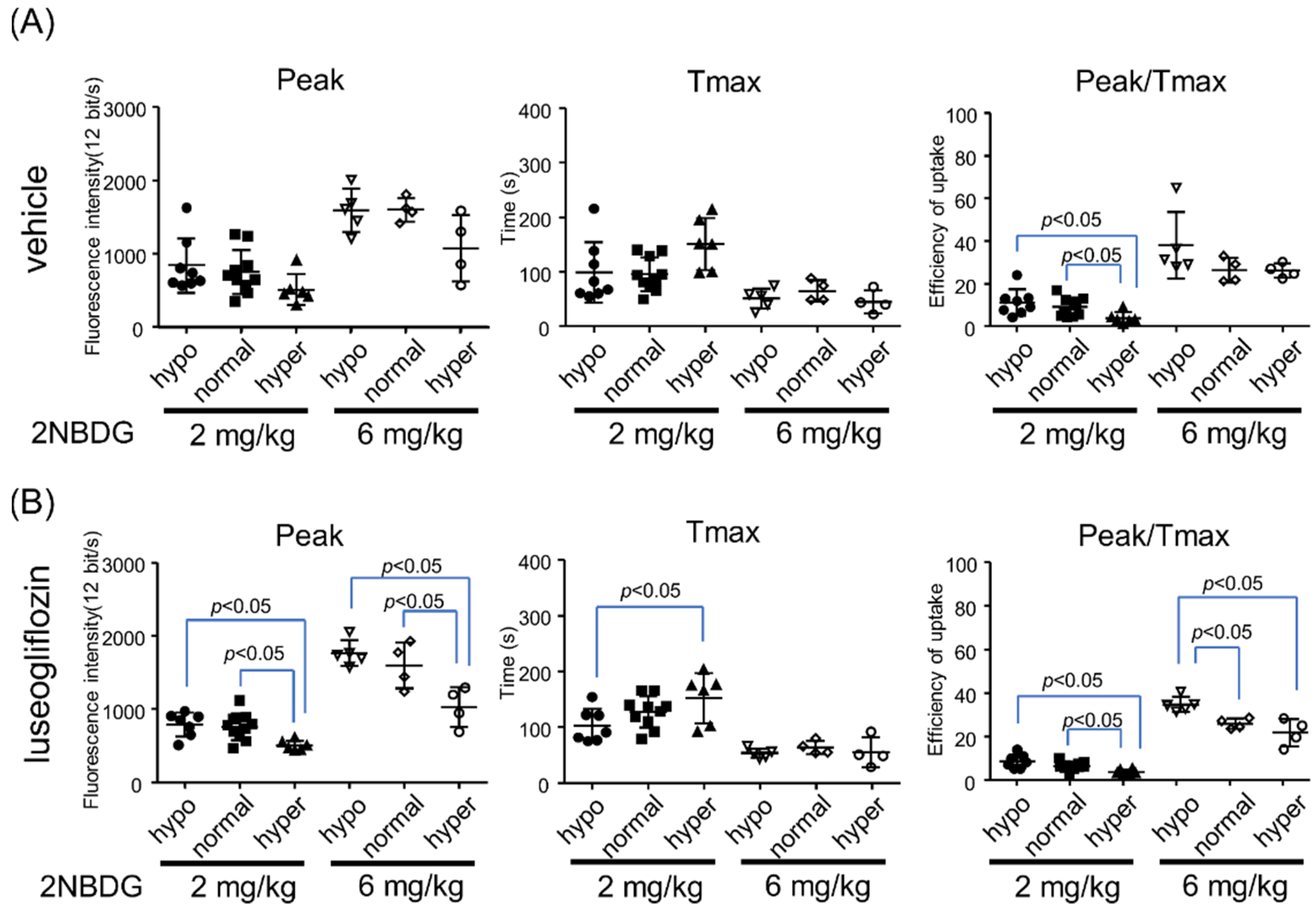
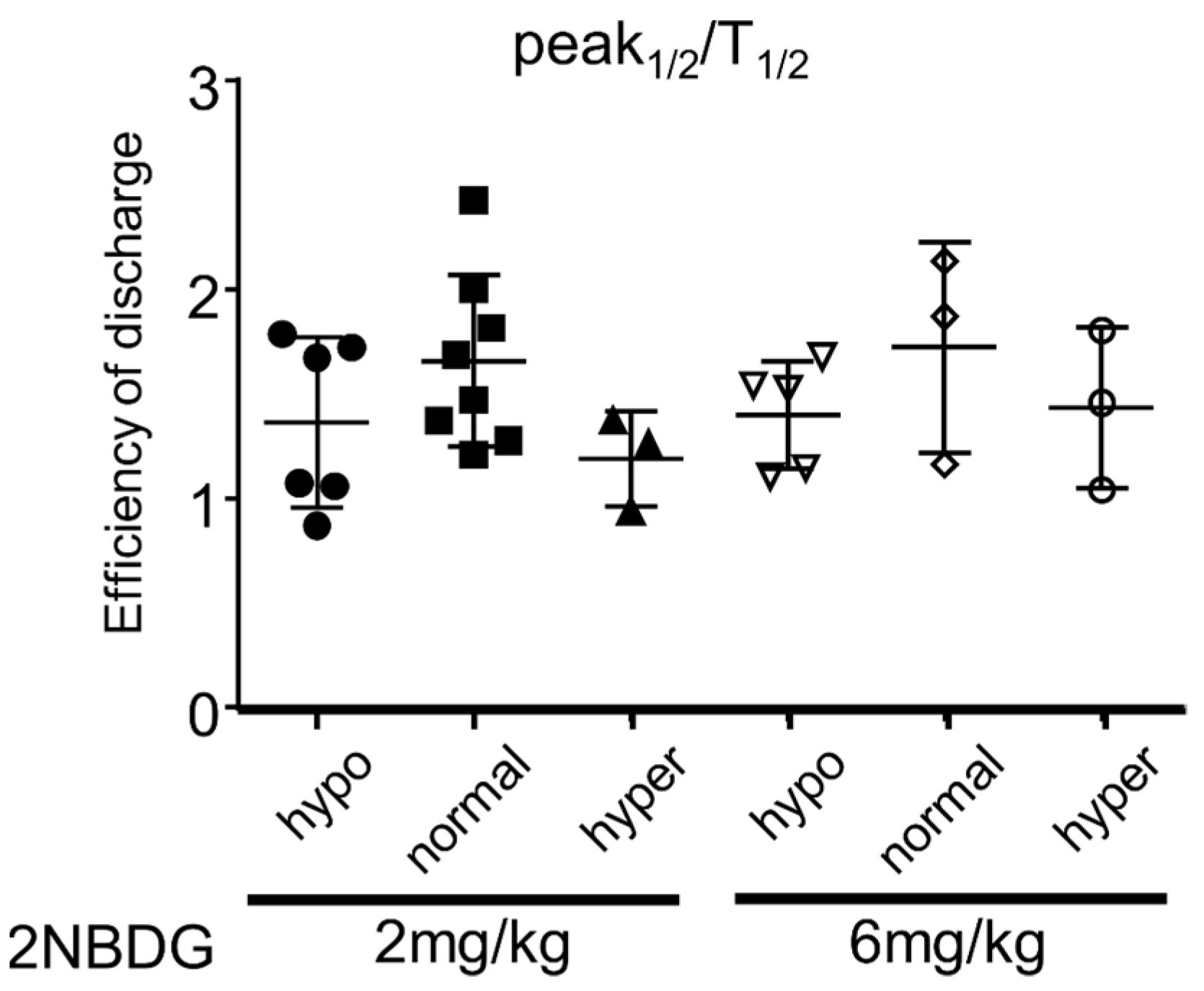
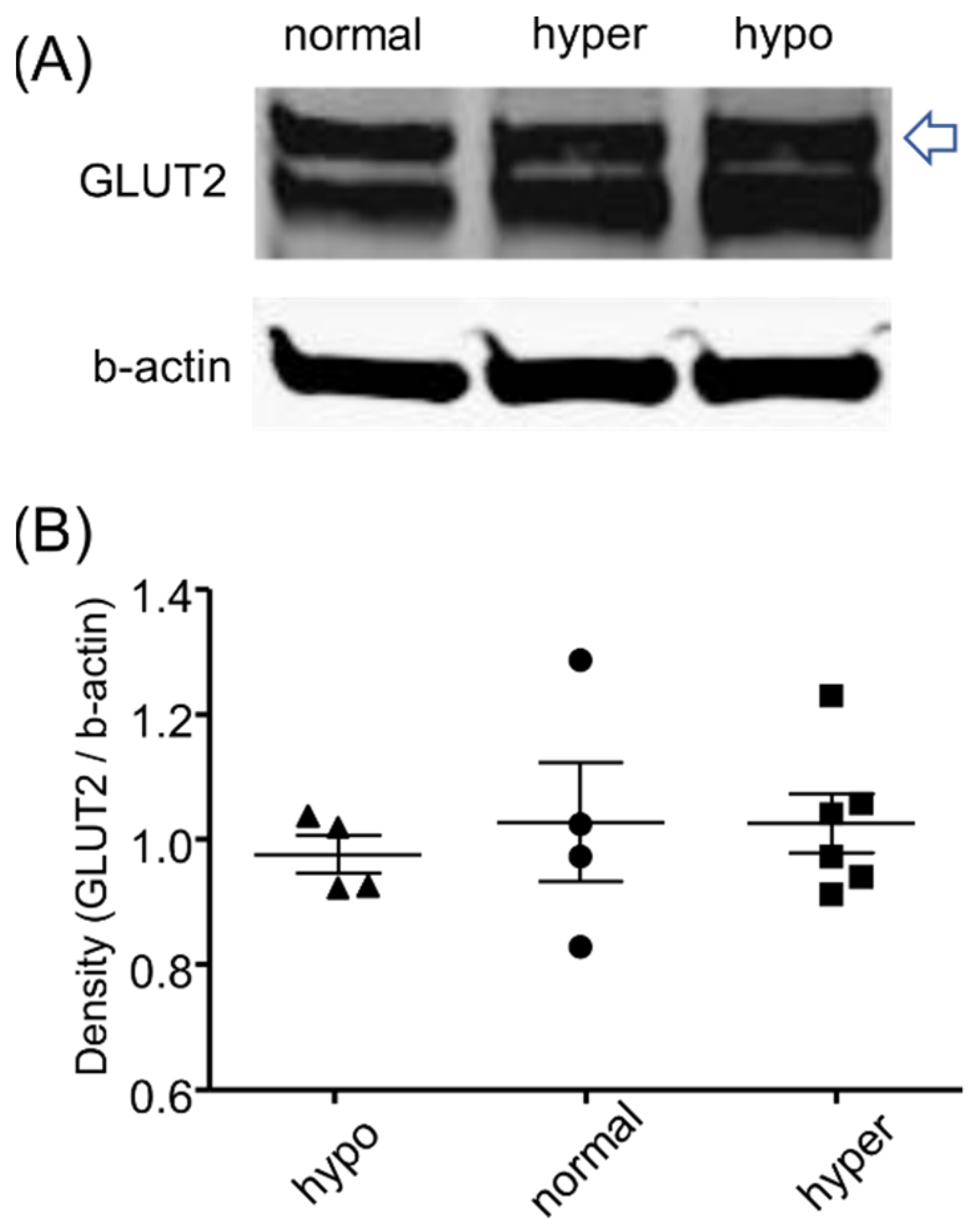
| Hypoglycemia | Normoglycemia | Hyperglycemia | |
|---|---|---|---|
| Vehicle | 51.69 ± 1.90 (n = 13) | 146.58 ± 6.70 (n = 12) | 412.42 ± 20.29 (n = 12) |
| Luseogliflozin | 53.67 ± 5.13 (n = 12) | 139.67 ± 7.97 (n = 12) | 296.75 ± 19.08 * (n = 12) |
Publisher’s Note: MDPI stays neutral with regard to jurisdictional claims in published maps and institutional affiliations. |
© 2021 by the authors. Licensee MDPI, Basel, Switzerland. This article is an open access article distributed under the terms and conditions of the Creative Commons Attribution (CC BY) license (https://creativecommons.org/licenses/by/4.0/).
Share and Cite
Zhang, A.; Nakano, D.; Kittikulsuth, W.; Yamashita, Y.; Nishiyama, A. Luseogliflozin, a SGLT2 Inhibitor, Does Not Affect Glucose Uptake Kinetics in Renal Proximal Tubules of Live Mice. Int. J. Mol. Sci. 2021, 22, 8169. https://doi.org/10.3390/ijms22158169
Zhang A, Nakano D, Kittikulsuth W, Yamashita Y, Nishiyama A. Luseogliflozin, a SGLT2 Inhibitor, Does Not Affect Glucose Uptake Kinetics in Renal Proximal Tubules of Live Mice. International Journal of Molecular Sciences. 2021; 22(15):8169. https://doi.org/10.3390/ijms22158169
Chicago/Turabian StyleZhang, Anqi, Daisuke Nakano, Wararat Kittikulsuth, Yuka Yamashita, and Akira Nishiyama. 2021. "Luseogliflozin, a SGLT2 Inhibitor, Does Not Affect Glucose Uptake Kinetics in Renal Proximal Tubules of Live Mice" International Journal of Molecular Sciences 22, no. 15: 8169. https://doi.org/10.3390/ijms22158169
APA StyleZhang, A., Nakano, D., Kittikulsuth, W., Yamashita, Y., & Nishiyama, A. (2021). Luseogliflozin, a SGLT2 Inhibitor, Does Not Affect Glucose Uptake Kinetics in Renal Proximal Tubules of Live Mice. International Journal of Molecular Sciences, 22(15), 8169. https://doi.org/10.3390/ijms22158169







